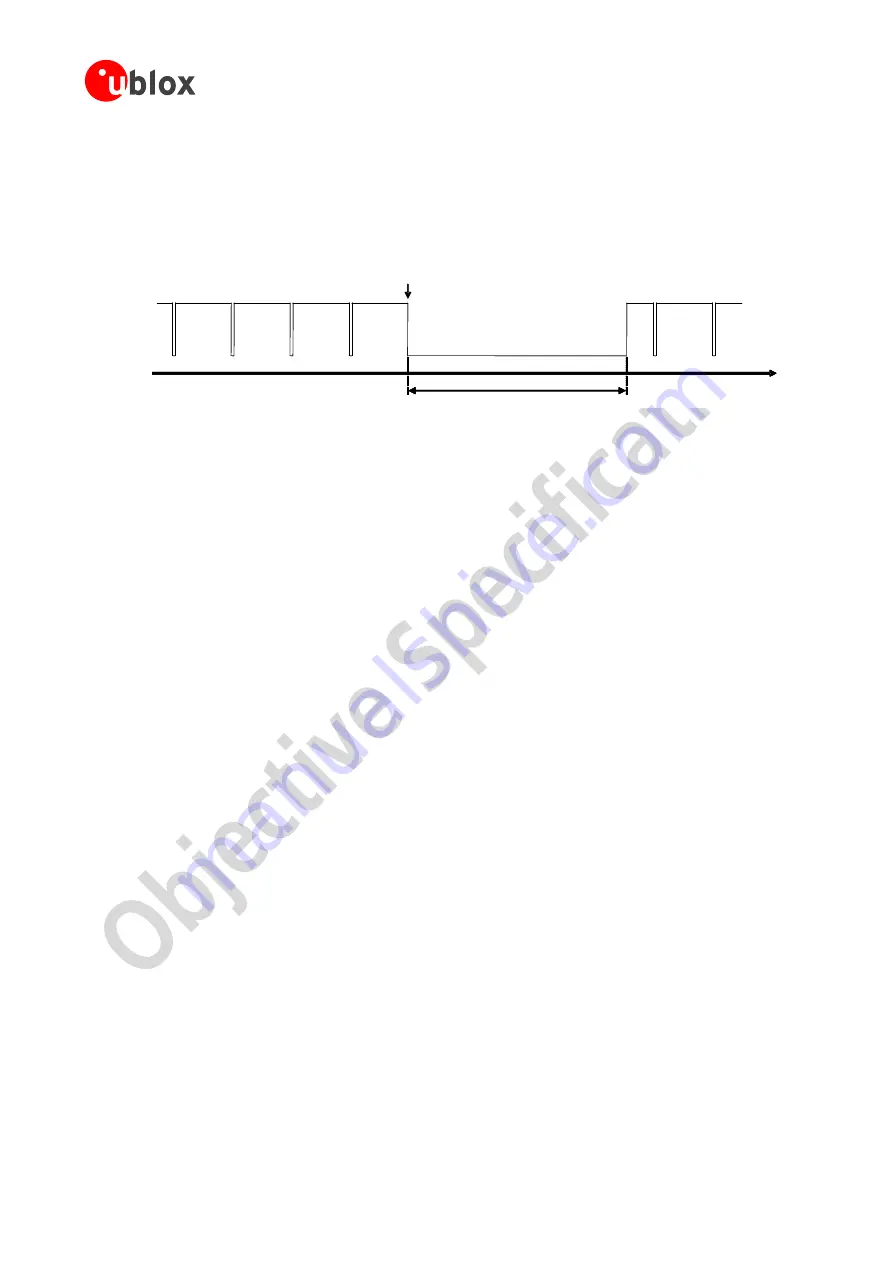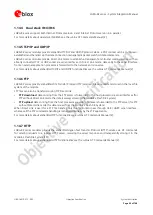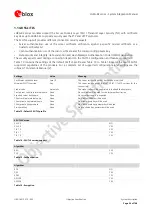
LARA-R2 series - System Integration Manual
UBX-16010573 - R02
Objective Specification
System description
Page 43 of 148
set from 40 2G-frames (i.e. 40 x 4.615 ms = 184 ms) up to 65000 2G-frames (i.e. 65000 x 4.615 ms = 300 s).
Default value is 2000 2G-frames (i.e. 2000 x 4.615 ms = 9.2 s). Every subsequent character received during the
active-mode, resets and restarts the timer; hence the active-mode duration can be extended indefinitely.
The
CTS
output line is driven to the ON or OFF state when the module is either able or not able to accept data
from the DTE over the UART: Figure 19 illustrates the
CTS
output line toggling due to paging reception and data
received over the UART, with AT+UPSV=1 configuration.
time [s]
~9.2 s (default)
Data input
CTS ON
CTS OFF
Figure 19: CTS output pin indicates when module’s UART is enabled (CTS = ON = low level) or disabled (CTS = OFF = high level)
AT+UPSV=2: power saving enabled and controlled by the RTS line
This configuration can only be enabled with the module hardware flow control disabled (i.e. AT&K0 setting).
The UART interface is disabled after the DTE sets the
RTS
line to OFF.
Afterwards, the UART is enabled again, and the module does not enter low power idle-mode, as following:
If an OFF-to-ON transition occurs on the
RTS
input, this causes the UART / module wake-up after ~20 ms:
recognition of subsequent characters is guaranteed only after the complete wake-up, and the UART is kept
enabled as long as the
RTS
input line is set to ON.
If the module needs to transmit some data (e.g. URC), the UART is temporarily enabled to send data
The module automatically enters the low power idle-mode whenever possible but it wakes up to active-mode
according to any required activity related to the network (e.g. for the periodic paging reception described in
section 1.5.1.4, or for any other required RF transmission / reception) or any other required activity related to the
module functions / interfaces (including the UART itself).
AT+UPSV=3: power saving enabled and controlled by the DTR line
The UART interface is disabled after the DTE sets the
DTR
line to OFF.
Afterwards, the UART is enabled again, and the module does not enter low power idle-mode, as following:
If an OFF-to-ON transition occurs on the
DTR
input, this causes the UART / module wake-up after ~20 ms:
recognition of subsequent characters is guaranteed only after the complete wake-up, and the UART is kept
enabled as long as the
DTR
input line is set to ON
If the module needs to transmit some data (e.g. URC), the UART is temporarily enabled to send data
The module automatically enters the low power idle-mode whenever possible but it wakes up to active-mode
according to any required activity related to the network (e.g. for the periodic paging reception described in
section 1.5.1.4, or for any other required RF signal transmission or reception) or any other required activity
related to the functions / interfaces of the module.
The AT+UPSV=3 configuration can be enabled regardless the flow control setting on UART. In particular, the HW
flow control can be enabled (AT&K3) or disabled (AT&K0) on UART during this configuration. In both cases, with
the AT+UPSV=3 configuration, the
CTS
line indicates when the module is either able or not able to accept data
from the DTE over the UART.
When the AT+UPSV=3 configuration is enabled, the
DTR
input line can still be used by the DTE to control the
module behavior according to AT&D command configuration (see
u-blox AT commands Manual
















































